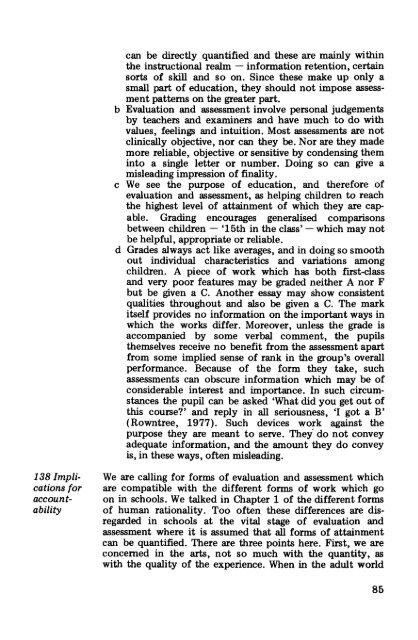The Arts in Schools - Calouste Gulbenkian Foundation
The Arts in Schools - Calouste Gulbenkian Foundation
The Arts in Schools - Calouste Gulbenkian Foundation
- No tags were found...
Create successful ePaper yourself
Turn your PDF publications into a flip-book with our unique Google optimized e-Paper software.
can be directly quantified and these are ma<strong>in</strong>ly with<strong>in</strong>the <strong>in</strong>structional realm — <strong>in</strong>formation retention, certa<strong>in</strong>sorts of skill and so on. S<strong>in</strong>ce these make up only asmall part of education, they should not impose assessmentpatterns on the greater part.b Evaluation and assessment <strong>in</strong>volve personal judgementsby teachers and exam<strong>in</strong>ers and have much to do withvalues, feel<strong>in</strong>gs and <strong>in</strong>tuition. Most assessments are notcl<strong>in</strong>ically objective, nor can they be. Nor are they mademore reliable, objective or sensitive by condens<strong>in</strong>g them<strong>in</strong>to a s<strong>in</strong>gle letter or number. Do<strong>in</strong>g so can give amislead<strong>in</strong>g impression of f<strong>in</strong>ality.e We see the purpose of education, and therefore ofevaluation and assessment, as help<strong>in</strong>g children to reachthe highest level of atta<strong>in</strong>ment of which they are capable.Grad<strong>in</strong>g encourages generalised comparisonsbetween children — '15th <strong>in</strong> the class' — which may notbe helpful, appropriate or reliable.d Grades always act like averages, and <strong>in</strong> do<strong>in</strong>g so smoothout <strong>in</strong>dividual characteristics and variations amongchildren. A piece of work which has both first-classand very poor features may be graded neither A nor Fbut be given a C. Another essay may show consistentqualities throughout and also be given a C. <strong>The</strong> markitself provides no <strong>in</strong>formation on the important ways <strong>in</strong>which the works differ. Moreover, unless the grade isaccompanied by some verbal comment, the pupilsthemselves receive no benefit from the assessment apartfrom some implied sense of rank <strong>in</strong> the group's overallperformance. Because of the form they take, suchassessments can obscure <strong>in</strong>formation which may be ofconsiderable <strong>in</strong>terest and importance. In such circumstancesthe pupil can be asked 'What did you get out ofthis course?' and reply <strong>in</strong> all seriousness, 'I got a B'(Rowntree, 1977). Such devices work aga<strong>in</strong>st thepurpose they are meant to serve. <strong>The</strong>y do not conveyadequate <strong>in</strong>formation, and the amount they do conveyis, <strong>in</strong> these ways, often mislead<strong>in</strong>g.138 Impli- We are call<strong>in</strong>g for forms of evaluation and assessment whichcations for are compatible with the different forms of work which goaccount- on <strong>in</strong> schools. We talked <strong>in</strong> Chapter 1 of the different formsability of human rationality. Too often these differences are disregarded<strong>in</strong> schools at the vital stage of evaluation andassessment where it is assumed that all forms of atta<strong>in</strong>mentcan be quantified. <strong>The</strong>re are three po<strong>in</strong>ts here. First, we areconcerned <strong>in</strong> the arts, not so much with the quantity, aswith the quality of the experience. When <strong>in</strong> the adult world85
















